-
Posts
782 -
Joined
-
Last visited
-
Days Won
2
Content Type
Profiles
Forums
Blogs
Gallery
Events
Store
Posts posted by Veteran
-
-
I rather agree with Rick about that un-identified award suspended to a crown. It could very well be a Second Empire (1852-1870) Legion of honor with its normal crown. That was the reason I mentioned France as one of the foreign countries who had bestowed awards on this gentleman.
I also like the idea of a Military band leader who would have made his way to the top. Possibly the Hofkapellemeister. The Second class of the Iron Crown was a prominent award, which certainly would have gone to a outstanding person in his profession making the top level close to the Sovereign's eye. It then would be a civilian award which fits with the white tie.
All this, of course, is pure guesswork. But rather fun, I would say.
Regards
Veteran
0 -
hello Verdun16
Interesting portrait and array of a variety of awards. The Commander of the Iron Cross would suggest a high ranking civilian official of some sort. The second class of the Order admitted the holder into the nobility (if he previously did not belong) with the title of baron until 1884.
The number and diversity of foreign awards (France, Bulgaria, Belgium etc...) points toward a member of the Foreign Service (Embassador or Minister). Or an official of the Court, possibly Protocol, who usually receive such awards from visiting Sovereigns.
He could, naturally, have been some one quite different.
Cheers
Veteran
0 -
Thank you both, very much, for this in-depth investigation on this Hannoverian cross.
I am not surprised it is difficult to clearly pin-down. The regular period awards shown are obviously different. On the other hand the cross I am trying to understand has a "true" look (for what that can be worth !).
The ribbon is really quite old and has been sown with the cross for a long time, no doubt. I would also say that it shows traces of wear. If the piece is not silver gilt, it is base gold alloy.
Has anyone heard of replacement pieces ?
From the superb pieces shown, I fully understand how and why this cross is very puzzling. Since Wild Card mentions the fact that "silver keep away" pieces are known to exist, does one know where and when they originated ? Were they outright fakes for collectors to be fooled by ?
As this most interesting debate devellops, I am reminded of the "replacement " Napoleonic orders manufactured in the mid XIXth century when veterans were allowed for the firist time in decades to wear imperial uniforms, on the occasion of the return of Napoleon's ashes from Saint Helena. Could the same kind of manufacturing have existed some time in the XIXth century for Hannoverian orders ?
Thank you again for sharing such outstanding expertise. I greatly appreciate your kindness.
Veteran
0 -
Yankee
I am very interested by your idea that this might be a badge made in Vienna, possibly after Sadowa. It is quite new to me.
How could this be documented ? Frankly, my knowledge of this Order is very slim.
Would Wild Card be prepared to agree ? I cannot say how much I am grateful for your careful analysis of this unusual badge.
Thank you very much
Veteran
0 -
Thank you both for your considered opinions.
The pictures shown and the comments exchanged suggest the cross I have shown might have been custom made... or could it be an outright copy ?
The look of its metal is quite different from the obvious gold of badges illustrating your messages. I now have a hunch it might well be gilt silver.
Incidentally, it was bought in 1971 and not 1968 as first mentioned. But its was bought in London as stated from the shop in Piccadilly Arcades.
This exchange is very interesting; as a old salt in the collecting fraternity I am open to truly expert advice, and I am very grateful when it comes. I sincerely hope you will please let me benefit further from your fine knowledge of this order.
The badge, as it is, remains a question mark.
Best regards
Veteran
0 -
Hello Yankee and Wild Card
I have carefully read your exchange of well informed messages, and I am very impressed. Sorry I could not come up earlier on the forum.
The additionnal info I can supply is this : the badge is larger than the types you described - (54 x 33 mm). The date is clearly MDCCCXV. and the cypher GR. No hallmark or other markings.
Your debate about British and German makers is facinating. I am sorry I cannot bring any further information about this particular badge, except that it was bought from a then very young dealer in London, John Hayward (he has certainly made his own way since those days ....in 1971).
I therefore assumed that it was a British-made cross. The blue ribbon is venerable, but nothing proves it is original, of course.
Thank you for your further learned comments
Veteran
0 -
Hello all.
This badge of the Hannoverian Order of the Guelphs with swords is rather flat. I wonder if its style could help date it ?

Every bit of information will be gratefully received
All the best
Veteran
 0
0 -
Hello dond
Please tell us what your favorite is. Some of these wonderful awards are well known to their owners but they are hard to trace for some of us folks.
I'm dying to know.
all the best
Veteran
0 -
Claudio
Lovely groups. Am I right to assume that the mounting of the first shown would point toward a member of the Imperial Navy ? The position of the EK on the right would mean the orders were worn obliquely from upper to lower and left to right.
Could you confirm ?
Regards
Veteran
0 -
BRUNSWICK.
Order of Henry the Lion. Steckkreutz
Certainly not the rarest, but one of the most elegant badges of the Imperial German States series.
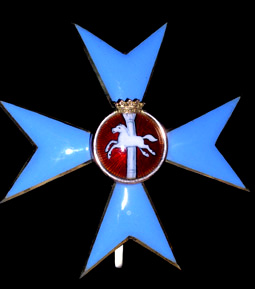
Regards
Veteran
 0
0 -
Jan
Thank you very much for this important reference. I will certainly try and get hold of a copy in French, as you have suggested.
Thanks to all the members on this forum whose help has been so significant for me to understand this strange and anusual medal. It means a lot more to me.
Greetings to all
Veteran
0 -
I saw a Outre mer with Tchad and Madagascar bars.
He must have just have bought one for wear and not really taken note.
best
Chris
Bonjour Jean Baptiste & Chris
Thank you for the very useful thread to the French site, which is indeed one of the best. It confirms the fact that the M?daille d'Outre-Mer received its first clasp with THAD, in the 1970s.
The medal Chris mentions is quite possible; the man would have been in the forces for a little over 20 years, nothing special. If he first had a M?daille coloniale for MADAGASCAR with its clas, and lost it, after the M?daille coloniale was replaced, he then would have received or bought the M?daille d'Outre-Mer since it was available, and the same award in many ways. Your observation clicks quite well with the case I reported in my first answer.
In other words, all kinds of combinations were technically possible with the late clasps of the Coloniale and early clasps of the M?daille d'Outre-Mer.
The only instance which I would consider improbable would be simultaneous wear of two medals or ribbons.
Best regards
Veteran
0 -
Good question Chris
The answer is PROBABLY that he would wear the new clasp(s) on the ribbon of his M?daille coloniale. The M?daille d'Outre-Mer is NOT a different award. It replaced the previous medal since its name was had lost its significance (no mone Colonies). I know of no instance of anyone wearing two ribbons side by side. Would simply not make sense.
One has to find now a M?daille coloniale with both bars INDOCHINE and EXTREME-ORIENT, for instance. I believe the last clasp to the M?daille coloniale was MADAGASCAR.
Let's see what other opinions crop up.
Regards
Veteran
0 -
As an addition to the former post, this picture of both reverses :
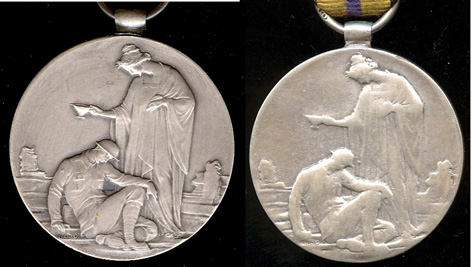
Thank you.
Veteran
 0
0 -
Hello
Since this group of posts is devoted to British awards to Belgian recipients, I hope my question will prove relevant.
The "Allied Subjectsr' Medal" was created by the British Government in 1920/22 to recognize outstanding help given by foreign nationals to British soldiers during WW1.
Very few medals were awarded (134 silver - 574 bronze) more than half of which went to Belgian nationals, which is the reason for my post being inserted here. The other medals went mostly to French citizens, as well as a few Dutch, Danish and members of half-a dozen other countries (Abbott & Tamplin " British Gallantry Awards" 1981).
This picture shows two silver Allied Subjects's Medals. The first is a genuine british stricking. The second is quite different, and was bought many years ago at auction in Paris.
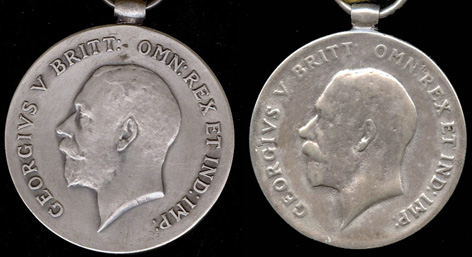
This second medal is obviously a replacement or a copy. Slightly smaller than the original (35mm copy/ 36mm original) the King's head is also smaller. The medal is silver for both, the "copy" bears the French "swan" hallmark for imported silver sold at auction. The main feature is its heavily polished look, erasing much of its details.
Since this very scarce medal, which was never named nor were the names of recipients ever published, obviously was dangereous to keep in occupied countries during WW2, I have come to wonder if replacements could not have been made for those that had been lost or carefully destroyed during that period.
The lack of silver hallmark might also suggests a Belgian origiin, if it is legitimate.
Very little seems to have been written on this subject, except the outstanding work by Abbot & Tampin. As far as I know, naturally.
Would members of this forum care to share their comments about these two medals, the question being : would any one know if replacements were ever made in Belgium ?
Best regards
Veteran
 0
0 -
Hello
Since this group of posts is devoted to British awards to Belgian recipients, I hope my question will prove relevant.
The "Allied Subjectsr' Medal" was created by the British Government in 1920/22 to recognize outstanding help given by foreign nationals to British soldiers during WW1.
Very few medals were awarded (134 silver - 574 bronze) more than half of which went to Belgian nationals, which is the reason for my post being inserted here. The other medals went mostly to French citizens, as well as a few Dutch, Danish and members of half-a dozen other countries (Abbott & Tamplin " British Gallantry Awards" 1981).
This picture shows two silver Allied Subjects's Medals. The first is a genuine british stricking. The second is quite different, and was bought many years ago at auction in Paris.

This second medal is obviously a replacement or a copy. Slightly smaller than the original (35mm copy/ 36mm original) the King's head is also smaller. The medal is silver for both, the "copy" bears the French "swan" hallmark for imported silver sold at auction. The main feature is its heavily polished look, erasing much of its details.
Since this very scarce medal, which was never named nor were the names of recipients ever published, obviously was dangereous to keep in occupied countries during WW2, I have come to wonder if replacements could not have been made for those that had been lost or carefully destroyed during that period.
The lack of silver hallmark might also suggests a Belgian origiin, if it is legitimate.
Very little seems to have been written on this subject, except the outstanding work by Abbot & Tampin. As far as I know, naturally.
Would members of this forum care to share their comments about these two medals, the question being : would any one know if replacements were ever made in Belgium ?
Best regards
Veteran
0 -
Thank you for these illustrations. The neck badge I have is identical to the middle one (with swords) you show. And the star looks very much like the larger of the two, plus swords, of course.
It does seem now established that the set is a genuine post-1915 Turkish Mint manufacture. I just have to understand the ribbon.
Best regards
Veteran
0 -
Thank you for these illustrations. The neck badge I have is identical to the middle one (with swords) you show. And the star looks very much like the larger of the two, plus swords, of course.
It does seem now established that the set is a genuine post-1915 Turkish Mint manufacture. I just have to understand the ribbon.
Best regards
Veteran
0 -
Rick
Your fine comments are most interesting. Close inspection of both badge and star in this set shows the Mint hallmark on the reverse, and the quality of the metal is comparable to stars of earlier manufacture. Obviously, they are properly made local productions.
A friend who reads arab script confirms that the lid of the presentation case carries the caption "Medjidjie 2". Which confirms the status of a Second Class award.
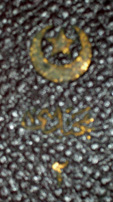
The question about the plain red neck-ribbon remains un-answered. I wonder if anyone has an idea about it. It certainly looks period 55mm wide.
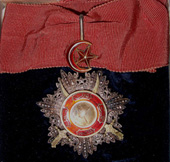
I am amazed and most grateful to find on this forum such expert advice about this difficult subject. And I remain hopeful that further information will possibly turn up. I am certainly open...
Regards

 0
0 -
Dear Paul,
If you look at ANS 2 there was a Turkish section which had a virtualy complete group of the Osmanie and Medjidie with scimitars. My suspicion is that the Ottoman Empire adopted such devices more for the benefit of Central Power allies than for their own troops. Certainly they are rare in all cases and extreme caution should be used by anyone thinking of purchasing examples as they have been (the scimitars) extensively faked (not suprising when you can multiply the value of a 5th Class badge by many times).
Paul
Dear Paul
Thank you for your constructive comment. THE ANS 2 catalogue is (as you may have seen) my absolute bible for these awards, since it is the most recent source published, with prices realized and outstanding pictures. When I mentioned n?520 in my previous messages, I had missed n?515 which is absolutely identical to the star in my set - but noticebly larger, .
As you say, a number of fakes seem to have been around; this set is in its original Mint presentation case. It "looks right".
Best regards
Paul
0 -
Wonderful picture of your star !!
Mine looks very much the same, but the size is smaller (85mm) and tremendeously thick (20mm !) with the crescents and stars an intermediate layer of sliver, between the star itself and the silver-gold-enamel piece carrying the swords.
Additionnal information is that the presentation case, from the Turkish Mint I believe, carries the numeral "2" which points to a 2nd class set. In which case, one would think that the star could have been either shaped like a 1st class (with 7th point looking down as on both your star and this one) or with the 7th point looking upwards as is the case with the ANS specimen.
Thank you for the additionnal information you offer. In fact, this set is the right size, the only oddity being the shape of the star, as compared with the one in the ANS Collection.
It does seem strange that more litterature is not available on the subject. After all, a large number of German (and Austrian ?) officers were seconded to the Turkish Army and Navy, therefore earning Turkish awards for their services.
Thank you very much. I will be delighted to hear more from those on the forum who will kindly share their thoughts about this set.
Best regards
Veteran
0 -
Sabers were added in 1915. No Ottoman award numbers have come out of the higgle piggle of their never sorted archives, but they are incredibly rare.
Marine Zahlmeister August B?ning (1891-1961, later the ONLY Konteradmiral (V) in the German navy) got his as the super star combat paymaster of the Tigris-Euphrates "canoe" fleet:
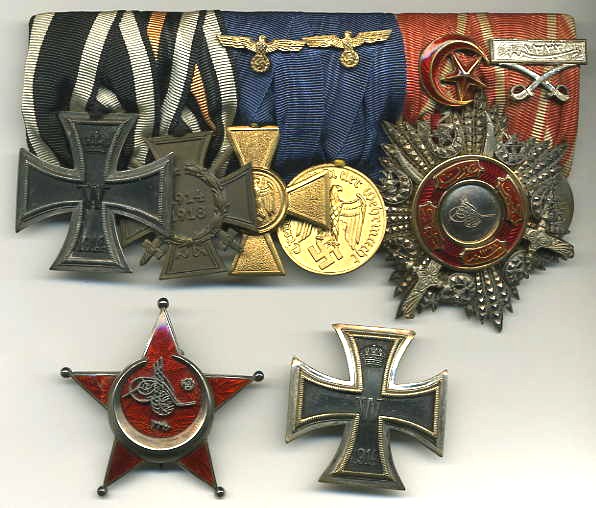
This is actually a "fashion super-sized" Vth Class.
Thank you both very much for your kick r?plies. I am most grateful.
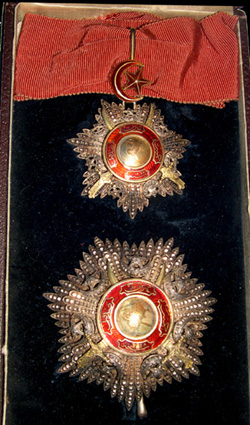
This rather indifferent picture (my apologies) shows what is to me a strange assortment : a neck badge and what looks very much like a first class star. The outstanding Morton & Eden sale of the American Numismatic Society collection held in London in October 2006 had a Second Class star (n?520)which was quite different - smaller and the seven points oriented differently. This one, with the swords, is identical to the First class star (518) also illustrated in that catalogue in the ordinary "civilian" class, very thick "3 layers".
The set shown is in its original turkish presentation case and has not been dabbled with. Also noticeable, the plain red ribbon, different from the usual red lined with green normal ribbon for the Order (would it be right ?).
The questions here are :
- is this a First Class set, a Second Class or an intermediate Class ?
- Were these awards for combat services only, or were they given in this form as a military class to all officers in the Forces ?
- As Rick has shown, these Turkish awards went to a number of German recipients. Were the "swords" specially devised to be given to the Germans and Austrian allies ?
Ed, of course, wets my appetite with his mention of numbers of awards. I sincerely hope he will be able to lay hands on the right file.
Thank you all for your help in making sense of this set.
Best regards
Veteran
 0
0 -
Hello
I am would like to known what period the Medjidj?h was awarded with Swords. It seems established that recipients of the Order among the Allies (British, French, Sardinians) received the "ordinary" badges during the Crimean War.
Also of interest, would be the category of recipients who would receive the Order with Swords after it had been created. Were all Military personnel awarded this type for any form of services (military division) or was it restricted to acts of gallantry ?
Since they do not appear very often, am I right to assume that the Order with the Swords was only created during WW 1 ? I don't seem to be able to locate much litterature on this particular subject.
Thank you all for your contribution and answers
Best regards
Veteran
0 -
Hello Jan
Thank you for this additionnal information which brings further knowledge to this badge. Now that you have mentionned it, "La Bran?onne" makes better sense to me as the Belgian Marseillaise.
You have drawn a "fransquillon" closer to Belgian history. I appreciate. Your conclusion that the colours of the ribbon (if it was a ribbon) be a tricolour is supported by an other of you compatriots on a different website; I do hope some one will turn up with a portrait wearing the medal.
Very best regards
Paul
0




What Did This Guy Do For A Living?
in Austro-Hungarian Empire
Posted
I guess you have made your point there, Yankee. It also fits with the ribbon seen on the photo.
Now, who was this gentleman ? Does anyone know ?
Veteran